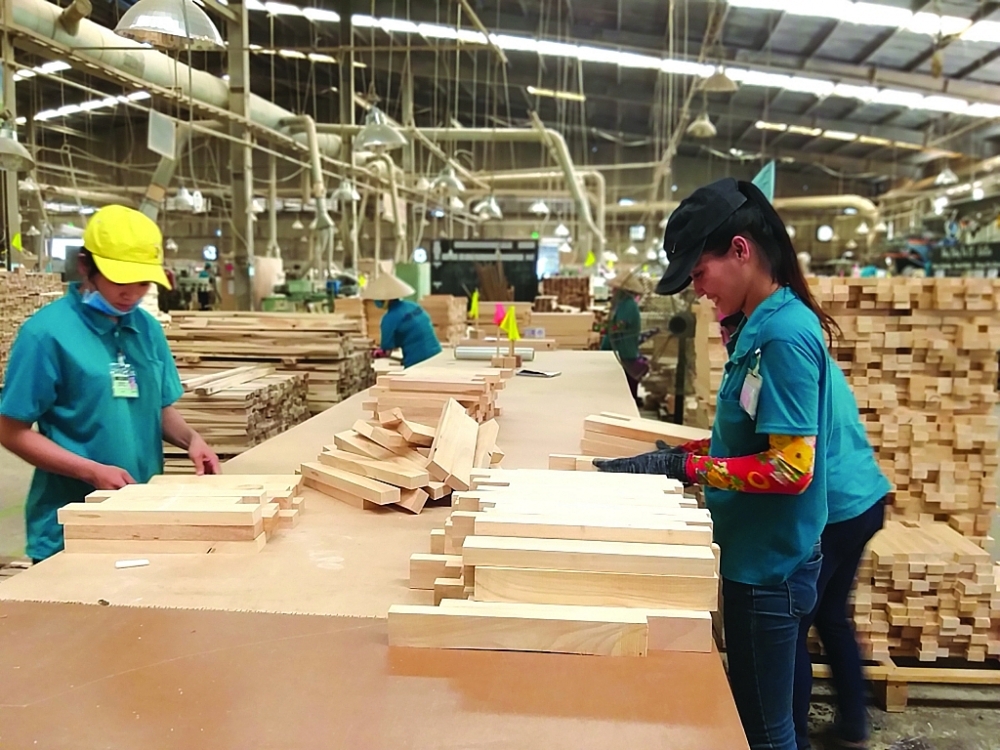| COVID-19 production suspension hampering timber exports |
 |
| It is forecast that from now until the end of the year, export orders of wood and wood products to the US and EU will continue to decline sharply. Photo: N. Thanh |
Orders from the US, EU decreased by more than 40%
Statistics from the General Department of Customs show that, in the first seven months of 2022, the export value of wood and wood products reached US$9.7 billion, an increase of only 1.1% over the same period in 2021.
In which, the value of wood product exports reached US$6.9 billion, down 7.5% over the same period in 2021. Currently, the United States is the main export market for Vietnam’s wood and wood products. The export value of wood and wood products to the US market in the first seven months of 2022 reached US$5.56 billion, down 5.6% over the same period in 2021.
“The export growth of the whole industry in the first seven months of 2022 is low compared to the same period in 2021 and previous years, mainly due to the high price of raw materials and products (the cost of production materials and transportation increased sharply),” Mr. Bui Chinh Nghia, Deputy Director of the General Department of Forestry (Ministry of Agriculture and Rural Development) said.
Countries tighten credit policies because inflation tends to increase, leading to a sharp decrease in consumer demand.
A representative of the Import-Export Department (Ministry of Industry and Trade) said: “In the context of inflation pressure weighing on the US economy, consumer demand in this country slowed down. When consumer demand in the world’s largest economy decreases, it will greatly affect Vietnam’s wood and wood product exporters. The decrease in exports of wood and wood products to the US is the main reason for slowing the growth of the wood industry.”
A survey conducted by a research group of Timber Associations and Forest Trends in mid-July 2022 to find out the current situation of the decline in wood export markets showed that 45 of 52 enterprises participated in the furniture export survey to the United States and 39 of 52 enterprises interviewed had products exported to the EU market.
Export sales of most enterprises, especially to the US and EU markets, decreased from the beginning of the year to July 20. Orders of enterprises from these markets also decreased. Specifically, in the United States, the number of orders of surveyed enterprises decreased by an average of 45.4%. Some businesses no longer have orders. In the EU market, enterprises reflected an average decrease of about 44.6%, of which one enterprise had a sharp decrease in orders from 80 to 100%. The number of export orders to other markets also had a high decrease, an average of 36.3%; some businesses have been reduced to 80%.
Mr. To Xuan Phuc, an expert from Forest Trends, said: “The rapid decline in export turnover of enterprises in recent months has shown that the export market is relatively gloomy.”
Difficult to “finish”
The enterprises participating in the survey all expected that the export situation would not improve much and the number of orders to all markets would continue to decline sharply in the remaining months of 2022.
The average decrease in the US, EU and UK markets is forecasted to be over 40% while the export situation in other markets had a lower decline.
Mr. To Xuan Phuc said that the signal of the output market for the remaining months of 2022 is not optimistic. Many enterprises are currently facing difficulties in aspects such as loans and production input costs in the context of declining input income.
Response measures that businesses are currently applying such as choosing to reduce production scale to cut costs; choosing to reduce product prices to stimulate demand and expanding customer markets in the EU and Australia is only short-term. “If the market continues to evolve as it is now, these short-term solutions will not help businesses much in maintaining their production and business activities. All of this shows the difficulty of the wood processing and export industry in achieving the export target of 2022,” said Mr. To Xuan Phuc.
In addition to the decrease in orders, the Vietnam Timber and Forest Products Association informed that the wood industry is also facing risks or other undesirable impacts.
Specifically, on April 22, 2022, the American Kitchen Cabinet Alliance (AKCA) sent an application to the US Department of Commerce (DOC) to initiate an investigation against trade defense tax evasion with imported wooden cabinets from Vietnam. The United States is considering abolishing import duties on some items, including wood products from China. This will likely cause customers and orders from Vietnam to return to China. It is very difficult for Vietnamese enterprises to compete.
In order to support businesses to reduce difficulties, many wood industry enterprises have proposed that the Government promote banks to allow debt rescheduling, reduce interest rates, extend due loans, and assist businesses in accessing preferential capital sources.
For tax and fee policies, businesses want the Government to allow the reduction and delay in paying corporate income tax and personal income tax, reducing land rent, and refunding value added tax as quickly as possible in order to pay capital for businesses and reduce the cost of importing and exporting seaport containers.
“Many businesses asked the Government to take timely measures to stabilize prices, reduce inspection; support workers to pay social insurance premiums, extend the time to pay social insurance premiums and design relief packages to promptly support enterprises to overcome the immediate difficult period and stabilize production in the long-term,” Mr. Do Xuan Lap, Chairman of Vietnam Timber and Forest Products Association, said.
